Abstract
Mucoepidermoid carcinoma (MEC) is the most common type of malignant neoplasm in the minor salivary gland. The hard palate is a frequently involved site of MEC. The treatment of low-grade MEC on the hard palate is wide local resection with a tumor-free margin. In the present case, the maxillary defect was reconstructed using a buccal fat pad (BFP) flap, followed by application of 4-hexylresorcinol (4HR) ointment for 2 weeks. The grafted BFP successfully covered the tumor resection defect without tension and demonstrated complete re-epithelialization without any complications.
Mucoepidermoid carcinoma (MEC) is the most common type of malignant tumor in the salivary gland and comprises approximately 12% to 23% of malignant tumors in the minor salivary gland1. The tumor can occur in the minor salivary gland of the lip, buccal mucosa, retromolar region, or tongue and floor of the mouth, but the most frequently involved site is the hard palate2. MEC of the hard palate presents as an asymptomatic, fixed, slow-growing swollen area, sometimes appearing red or blue in color, is fluctuant and ulcerative, and invades the underlying bone3. MEC is categorized as either low, intermediate, or high based on histology1. MEC has diverse biological features and variable clinical symptoms depending on the grade and stage of the tumor4. Low-grade MEC is generally slow growing and benign, while high-grade MEC is more aggressive, invades the tissue, and metastasizes 4. Treatment of low-grade MEC is wide local resection with a tumor-free margin3. When low-grade MEC arises in the hard palate, the tumor is resected along with the involved palate mucosa and any underlying bone5.
A posterior maxillary or hard palate defect can be successfully covered with a pedicled buccal fat pad (BFP) flap6. BFP has been introduced as a pedicled flap for the closure of oroantral communication7 and has been successfully used to cover oral defects in the posterior maxilla, hard and soft palate, and retromolar region after tooth extraction, saucerization, and tumor resection6. BFP is located in the masseteric space between the buccinator muscle and the mandibular ramus and masseter muscle and receives a rich blood supply from the superficial temporal, internal maxillary, and facial arteries8. Due to its anatomic location, the BFP can be easily accessed and harvested via an intraoral approach and applied to the posterior oral cavity6.
4-Hexylresorcinol (4HR) is a well-known antiseptic used as an ingredient in mouthwash9. Because the oral cavity is a septic area, 4HR can be used to prevent postoperative infection9. In addition, 4HR differentiates oral cancer cells by increasing the expression of involucrin and keratin 1010. The BFP contains abundant stem cells that can differentiate the oral epithelium11. If 4HR could accelerate the differentiation of BFP-originated stem cells to the oral epithelium, overall healing time would be reduced. Our recent research showed that 4HR ointment suppressed the expression of tumor necrosis factor-α (TNF-α) in burn wounds and increased the epithelialization of skin wounds12.
We present a patient diagnosed with low-grade MEC on the left maxillary alveolus and hard palate. The malignant tumor was excised using partial maxillectomy, and the defect was covered with a simple pedicled BFP flap, followed by application of 4HR ointment to heal the wound.
A 61-year-old male was referred from a local clinic for continuous swelling of his left maxillary edentulous area after a tooth extraction. He had asymptomatic swelling on the left hard palate and an ulcerative lesion on the left maxillary alveolus.(Fig. 1) A panoramic view showed generalized bone destruction in the left posterior maxillary area, and incisional biopsy was performed for further evaluation. On histological examination, neoplastic proliferation of the epithelial cells, which contained mucous cells, was observed. Tumor cells showed low-grade cellular malignancy. The biopsy result was low-grade MEC on the left hard palate. Magnetic resonance imaging (MRI) was performed, and the mass was observed with central necrosis in the left hard palate.(Fig. 2. A) The mass had destroyed the alveolar process of the maxilla and extended into the soft palate, left maxillary sinus, and inferior wall of the left nasal cavity.(Fig. 2. B) Multiple nodularshaped lymph nodes were observed around the submandibular gland on contrast-enhanced computed tomography (CT). Metastasis of the lymph nodes was suspected in the submental, submandibular, and upper jugular areas based on positron emission tomography (PET) CT (PET-CT).
Under general anesthesia, a partial maxillectomy was performed from the left maxilla canine to the posterior maxillary tuberosity. The resected tumor mass was approximately 6×4 ×3 cm.(Fig. 3) An elective neck dissection was performed to remove the left submental, submandibular, and upper jugular lymph nodes. Evidence of nodal metastasis was not observed in the frozen biopsy. After surgical resection, the BFP was harvested and advanced to the defect. The left maxillary sinus and hard palate were successfully covered without tension. (Fig. 4)
Upon histological examination, mucin-producing cells mixed with epithelioid tumor cells were evident in the main tumor mass. A small microcystic formation was also observed. Histological diagnosis confirmed low-grade MEC. We applied 4HR ointment on the BFP-grafted area 1 day after surgery to promote re-epithelialization. A palatal stent was then applied to prevent the loss of ointment. 4HR ointment was applied once a day for 2 weeks. Re-epithelialization of the grafted BFP was observed 20 days after surgery (Fig. 5. A), and the defect was completely covered without any complication 8 weeks after surgery.(Fig. 5. B) MRI showed that the BFP was located in the left maxillary alveolus and hard palate defect.(Fig. 6) Evidence of recurrence and distant metastasis were not observed on PET-CT at the 5-month follow-up visit.
MECs are classified into low, intermediate, and high grades depending on the relative portion of cell types4. MEC is composed of various types of cells including mucous-producing, squamous, and intermediate1. Low-grade MEC has abundant mucous-producing cells, cystic structures, and few squamous cells3. Intermediate-grade MEC is histologically between low-grade and high-grade MEC and has fewer cysts and more prominent intermediate cells with a minor degree of mitotic activity and cellular atypia1. High-grade MEC has a relatively high proportion of squamous cells, a greater degree of mitotic activity, and infrequent mucous-producing cells or cysts1. High-grade MEC has local infiltration and grows aggressively, similar to squamous cell carcinoma4. Radiologically, high-grade MEC has irregular, poorly-defined margins and infiltrative adjacent tissue, while low-grade MEC demonstrates a well-delineated mass similar to a benign tumor3.
The MEC treatment varies based on the tumor location, clinical stage, and histological grade3. If MEC occurs in the parotid gland, a parotidectomy is performed, and the facial nerve will be excised413. MEC of the minor salivary gland in the hard palate is treated with wide local resection3. Low-grade MEC is surgically excised in a single piece along with the involved underlying mucosa and bone for an adequate tumor-free margin5. High-grade MEC has local infiltration and regional lymph node metastasis1415, requiring wider surgical resection with postoperative radiotherapy or chemotherapy116. Lymph node metastasis can occur in low-grade MEC1.
The biopsy result of the present case was low-grade MEC, and a reactive lymph node was suspected around the left submandibular gland based on contrast CT. Therefore, elective neck dissection was performed along with tumor resection. Low-grade MEC has a favorable prognosis; the 5-year survival rate is 76% to 95%, and recurrence has rarely been reported17.
The BFP has been widely used as a pedicled flap in the oral cavity for closure of an oroantral fistula, coverage of a sequestrectomy defect in osteomyelitis, regenerative treatment of peri-implantitis, and treatment of oral submucous fibrosis68. Reconstruction using the BFP is considered a reliable technique due to an excellent blood supply, minimal morbidity, easy harvest, and simplicity18. The posterior maxilla, hard palate, and retromolar trigone are the ideal defects for reconstruction with the BFP due to anatomical proximity to these areas6. The BFP provides a 7×4×3 cm pedicled tissue when proper dissection and advancement are performed11. Many authors recommend reconstructive surgery using the BFP with defects smaller than 4×5-cm size18. Our patient's MEC specimen measured approximately 6×4×3 cm.(Fig. 3) The involved defect area was the left maxillary canine to the tuberosity, the hard palate, and the sinus mucosa floor. We carefully harvested and advanced the BFP flap and successfully covered the defect without tension.(Fig. 4)
Epithelization of the grafted BFP begins 1 week after surgery, and complete healing is noted within 4 to 6 weeks6. This is accomplished by migration of the epithelial cells from the surrounding tissue in the flap margin19. At first, the superficial layer of the BFP is replaced with granulation tissue; however, this eventually turns into stratified squamous epithelium18. Histologically, parakeratotic squamous epithelium covers the healed site, and dense fibrous connective tissue is present in the subcutaneous stroma18. To promote re-epithelialization of the large graft area, we applied 4HR ointment on the BFP area due to its antiseptic and broad-spectrum antibacterial properties10. 4HR inhibits foreign body giant cell formation via the diacylglycerol kinase (DAGK)-mediated pathway20 and suppresses the expression of TNF-α12. In a recent study, 4HR ointment was applied to a burn wound, and rapid epithelialization and collagen regeneration occurred12. In the present study, we applied 4HR ointment on the graft area for rapid re-epithelialization. The large graft area was re-epithelialized 20 days after surgery.(Fig. 5. A) During the healing process, minimal complications such as infection, hematoma, or partial necrosis were noted11. However, these complications have rarely been reported, and as in our previous study, most cases of BFP flap successfully covered the saucerization defect without any complications14. In the present case, the grafted BFP was completely epithelialized and covered the defect.(Fig. 5. B)
The hard palate is a frequently involved site of low-grade MEC14. We surgically resected low-grade MEC on the left maxillary alveolus and hard palate and successfully covered the large defect with a BFP flap. 4HR ointment was applied to the fat graft area for rapid re-epithelialization and wound healing. The grafted BFP was completely re-epithelialized without complication. Based on the results from this case, we confirmed that BFP grafting is a simple, reliable, and minimally complicated technique for reconstruction of posterior palatal defects, and 4HR is a clinically useful ingredient to promote re-epithelialization of fat.
Notes
References
1. Brandwein MS, Ivanov K, Wallace DI, Hille JJ, Wang B, Fahmy A, et al. Mucoepidermoid carcinoma: a clinicopathologic study of 80 patients with special reference to histological grading. Am J Surg Pathol. 2001; 25:835–845. PMID: 11420454.
2. Caccamese JF Jr, Ord RA. Paediatric mucoepidermoid carcinoma of the palate. Int J Oral Maxillofac Surg. 2002; 31:136–139. PMID: 12102409.

3. Baumgardt C, Günther L, Sari-Rieger A, Rustemeyer J. Mucoepidermoid carcinoma of the palate in a 5-year-old girl: case report and literature review. Oral Maxillofac Surg. 2014; 18:465–469. PMID: 25109695.

4. Kokemueller H, Brueggemann N, Swennen G, Eckardt A. Mucoepidermoid carcinoma of the salivary glands--clinical review of 42 cases. Oral Oncol. 2005; 41:3–10. PMID: 15598579.

5. Nabil S, Lo RC, Choi WS. Simultaneous radicular cyst and mucoepidermoid carcinoma in the maxilla: a diagnostic nightmare. BMJ Case Rep. 2013; DOI: 10.1136/bcr-2013-010290.

6. Youn T, Lee CS, Kim HS, Lim K, Lee SJ, Kim BC, et al. Use of the pedicled buccal fat pad in the reconstruction of intraoral defects: a report of five cases. J Korean Assoc Oral Maxillofac Surg. 2012; 38:116–120.

7. Egyedi P. Utilization of the buccal fat pad for closure of oro-antral and/or oro-nasal communications. J Maxillofac Surg. 1977; 5:241–244. PMID: 338848.

8. Yeh CJ. Application of the buccal fat pad to the surgical treatment of oral submucous fibrosis. Int J Oral Maxillofac Surg. 1996; 25:130–133. PMID: 8727586.

9. Lee SW, Um IC, Kim SG, Cha MS. Evaluation of bone formation and membrane degradation in guided bone regeneration using a 4-hexylresorcinol-incorporated silk fabric membrane. Maxillofac Plast Reconstr Surg. 2015; 37:32. PMID: 26709373.

10. Kim SG, Kim AS, Jeong JH, Choi JY, Kweon H. 4-hexylresorcinol stimulates the differentiation of SCC-9 cells through the suppression of E2F2, E2F3 and Sp3 expression and the promotion of Sp1 expression. Oncol Rep. 2012; 28:677–681. PMID: 22664654.

11. Rapidis AD, Alexandridis CA, Eleftheriadis E, Angelopoulos AP. The use of the buccal fat pad for reconstruction of oral defects: review of the literature and report of 15 cases. J Oral Maxillofac Surg. 2000; 58:158–163. PMID: 10670594.

12. Ahn J, Kim SG, Kim MK, Kim DW, Lee JH, Seok H, et al. Topical delivery of 4-hexylresorcinol promotes wound healing via tumor necrosis factor-α suppression. Burns. 2016; 42:1534–1541. PMID: 27198070.

13. Kim IK, Cho HW, Cho HY, Seo JH, Lee DH, Park SH. Facelift incision and superficial musculoaponeurotic system advancement in parotidectomy: case reports. Maxillofac Plast Reconstr Surg. 2015; 37:40. PMID: 26550560.

14. Rapidis AD, Givalos N, Gakiopoulou H, Stavrianos SD, Faratzis G, Lagogiannis GA, et al. Mucoepidermoid carcinoma of the salivary glands. Review of the literature and clinicopathological analysis of 18 patients. Oral Oncol. 2007; 43:130–136. PMID: 16857410.
15. Kim BG, Kim JH, Kim MI, Han JJ, Jung S, Kook MS, et al. Retrospective study on factors affecting the prognosis in oral cancer patients who underwent surgical treatment only. Maxillofac Plast Reconstr Surg. 2016; 38:3. PMID: 26807400.

16. Kim CM, Park MH, Yun SW, Kim JW. Treatment of pathologic fracture following postoperative radiation therapy: clinical study. Maxillofac Plast Reconstr Surg. 2015; 37:31. PMID: 26709372.

17. Mesolella M, Iengo M, Testa D, DI Lullo AM, Salzano G, Salzano FA. Mucoepidermoid carcinoma of the base of tongue. Acta Otorhinolaryngol Ital. 2015; 35:58–61. PMID: 26015654.
18. Samman N, Cheung LK, Tideman H. The buccal fat pad in oral reconstruction. Int J Oral Maxillofac Surg. 1993; 22:2–6. PMID: 8459117.

19. Hanazawa Y, Itoh K, Mabashi T, Sato K. Closure of oroantral communications using a pedicled buccal fat pad graft. J Oral Maxillofac Surg. 1995; 53:771–775. discussion 775-6. PMID: 7595791.

20. Kweon H, Kim SG, Choi JY. Inhibition of foreign body giant cell formation by 4-hexylresorcinol through suppression of diacylglycerol kinase delta gene expression. Biomaterials. 2014; 35:8576–8584. PMID: 25023393.
Fig. 1
Clinical photograph showing the swelling and ulceration of the left maxillary alveolus and hard palate.
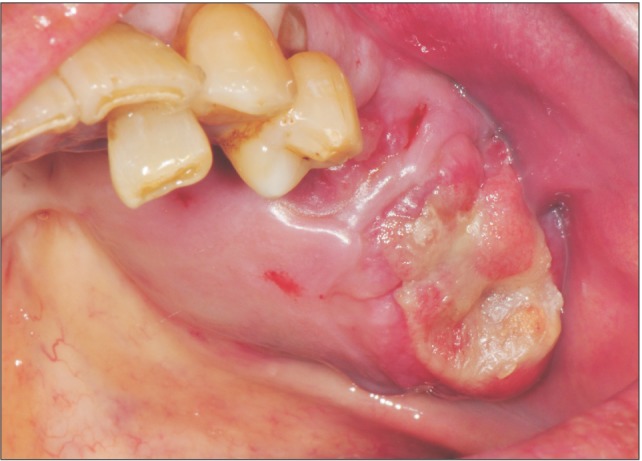
Fig. 2
Magnetic resonance imaging of the left hard palate. A. Tumor mass with central necrosis on the left hard palate. B. Extension of the tumor to the soft palate, left maxillary sinus, and inferior wall of the left-side nasal cavity.
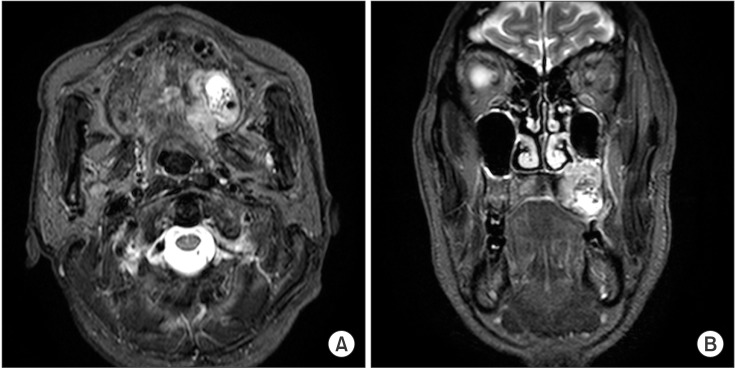
Fig. 3
Excised specimen was approximately 6×4×3 cm in size. Histological diagnosis was low-grade mucoepidermoid carcinoma.
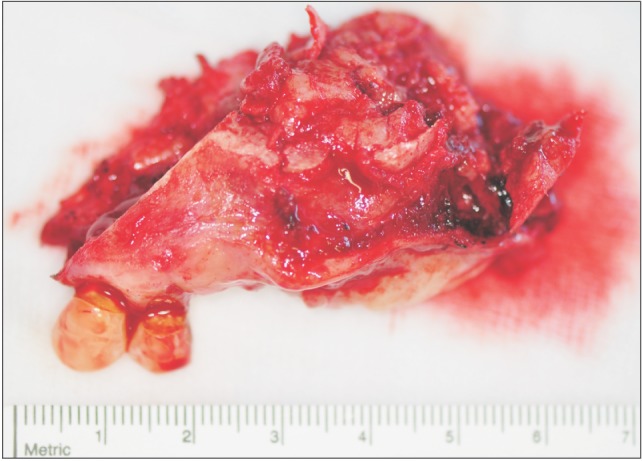




 PDF
PDF ePub
ePub Citation
Citation Print
Print



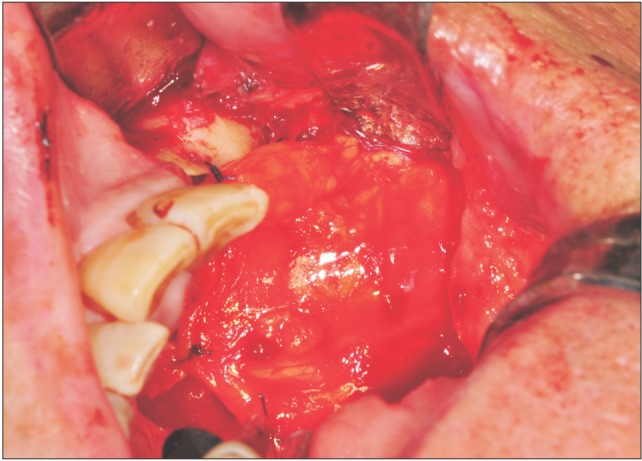

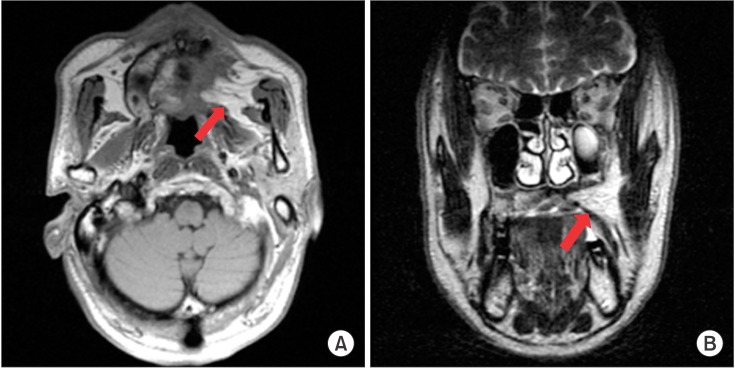
 XML Download
XML Download